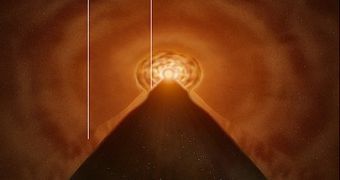Lately, astronomers using the Very Large Telescope Interferometer have been able to probe parts of the material disk around a growing star, in order to determine how massive stars collect gas before becoming main sequence stars. The targeted object was a star in the Monoceros constellation, dubbed MWC 147. This particular star is part of a family of objects known as Herbig Ae/Be and sits more that 2,600 light years away from Earth.
Although it has not yet reached its adulthood MWC 147 is already the size of our Sun, and is continuing to grow. It is estimated to be about one million years old and, by the look of the spinning disk of matter around it, it will grow into a massive star that will end its life somewhere in the next 35 million year, while our own Sun is more than 4,6 billion years old and is predicted to radiate light for another 5 billion years, before growing into a Red Giant.
Studying the structure and characteristics of the material disk around a particular star may not seem as much fun, but it presents astronomers a model that explains how stars and planets around them form. Observations in the near infrared and mid infrared made with the VLTI MIDI and AMBER instruments, corroborated with optical observations from the VLT, enabled astronomers to imply interferometry techniques to measure the material disk in a board range of wavelengths, which bring to evidence different temperatures inside it.
The study showed that the material from the disk closest to the star reaches temperatures of a few thousand degrees and the temperature decreases with the distance, exactly as expected. On the other hand, it seems that temperatures drops at much higher rates than theory predicted, as the distance to the star grows, suggesting that most of the near infrared emissions are emitted from the inner regions of the disk, located within about one to two astronomical units from the star.
This means that the dust located too close to the star would be blown away relatively fast by the intense heat. Furthermore, mathematical models show that, in fact, the near infrared emissions do not come only from the outer regions surrounding the dust disk but also from within it, suggesting that light coming from the star is filtered through the whole mass of dust and converted to infrared.
According to Stefan Kraus, one of the participants in the study, this basically means that the material disk is active and is routinely transporting mass from the outer regions towards the star to feed its growth process. The model has also shown that the annual mass increase of the MWC 147 star fits perfectly with a material disk spanning about 100 astronomical units away from the star.

 14 DAY TRIAL //
14 DAY TRIAL //